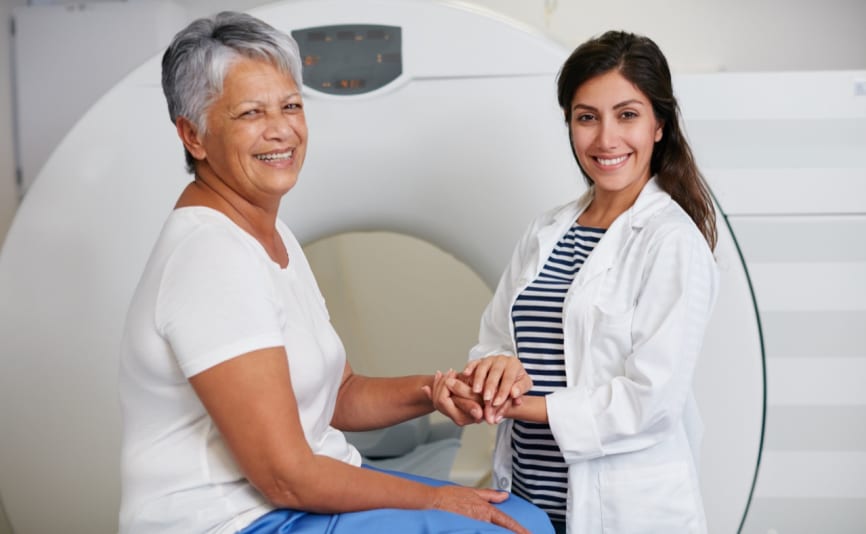MRI scans can assess the prostate's shape and health
"Every man with suspected prostate cancer should have an MRI scan," The Guardian reports. That is the conclusion of a study looking at how well MRI scans compare with the current practice of biopsies; removing sections of prostate tissue for analysis.
Disadvantages of prostate biopsies include the fact that they can lead to a small risk of side effects, some of which can be serious, such as sepsis.
Researchers were looking at an advanced type of MRI scan, known as a multi-parametric MRI, which as well as looking at the shape and size of the prostate, can also assess other factors such as blood flow through the gland.
The scan was used on more than 500 British men. The results suggest that scanning would safely reduce the number of men needing a biopsy by about a quarter. Moreover, in men with an aggressive prostate cancer the combination of MRI scan followed by a biopsy is almost twice as likely to pick up clinically significant cancer.
The National Institute for Health and Care Excellence (NICE) is currently considering this new diagnostic method to decide whether introducing it will be cost-effective.
Possible prostate problems? When to seek advice
Prostate cancer does not normally cause symptoms until the cancer has grown large enough to put pressure on the urethra (the tube that runs from the bladder to the penis).
This normally results in problems associated with urination, such as:
• needing to urinate more frequently, often during the night
• needing to rush to the toilet
• difficulty in starting to pee (hesitancy)
• straining or taking a long time while urinating
• weak flow
• feeling that your bladder has not emptied fully
If you notice any problems or changes to your usual pattern of urination, see your GP. These symptoms don't mean you have prostate cancer but you should get them checked out.
What kind of research was this?
This was a prospective paired cohort trial known as the Prostate MRI Imaging Study (PROMIS), that recruited men with suspected prostate cancer. All the men would previously have been advised to have a prostate biopsy. Men were each offered two diagnostic tests: the traditional diagnostic test, transrectal ultrasound guided biopsy (TRUS-biopsy) and the new diagnostic test involving multi-parametric magnetic resonance imaging (MP-MRI). The tests were done in addition to a template prostate mapping biopsy (TPM-biopsy). This is a reference standard against which the detection rates of each previous approach could be evaluated. Because both diagnostic tests were performed on each man participating in the trial, they can be directly compared with the reference standard and the benefits of using both in sequence can be evaluated. Cohort studies provide the best evidence when looking at diagnostic tests.
What did the research involve?
Researchers included 576 men within the UK who had a clinical suspicion of prostate cancer, for example an elevated PSA level (prostate specific antigen – a hormone associated with prostate enlargement) within the previous three months, and had been advised to have a prostate biopsy. Men first underwent the new diagnostic test – the multi-parametric Magnetic Resonance Imaging (MP-MRI), which provides information on not just tissue anatomy, but also tissue characteristics such as prostate volume. Men then underwent the traditional transrectal ultrasound-guided prostate biopsy (TRUS-biopsy). Another test was undertaken just before the traditional TRUS-biopsy in the same procedure under anaesthesia to minimise infection risk: the transperineal template prostate mapping biopsy (TPM-biopsy). This test was undertaken as the standard for comparison as it is highly accurate, although not commonly used as it is thought too invasive for routine use. Patients and the clinicians undertaking the traditional TRUS-biopsy were unaware of the results of the previous MP-MRI.
What were the basic results?
From the standard comparison test, using the TPM-biospy, 408 of 576 men had cancer with 230 of 576 men having clinically significant cancer.
For clinically significant cancer, the MP-MRI test was more sensitive (93%, 95% confidence interval [CI] = 88% to 96%) than the traditional TRUS-biopsy alone (48%, 95% CI = 42% to 55%).
The negative predictive value was 89% (95% CI = 83% to 94%). This ability for a negative result to rule out disease led to 158 (27%) of 576 men having a negative MP-MRI. Meaning that using MP-MRI might allow 27% of patients to avoid a biopsy at all.
However, the MP-MRI had a specificity of 41% (95% CI = 36% to 46%) compared with the TRUS-biopsy (96%, 95% CI = 94% to 98%). This means that the TRUS biopsy is better at diagnosing whether the people tested have disease or not and therefore is still needed.
This meant that in combination the MRI test followed by the biopsy was almost twice as likely to pick up clinically significant cancer than biopsy alone.
How did the researchers interpret the results?
The researchers conclude that the "TRUS-biopsy performs poorly as a diagnostic test for clinically significant prostate cancer."
They suggest that "MP-MRI, used as a triage test before first prostate biopsy, could identify a quarter of men who might safely avoid an unnecessary biopsy and might improve the detection of clinically significant cancer."
Conclusion
Overall, this study provides good evidence that using an MP-MRI test before a biopsy can result in a much lower proportion of men undergoing unnecessary biopsy. The combination helps detect cancer and avoid unnecessary treatment.





